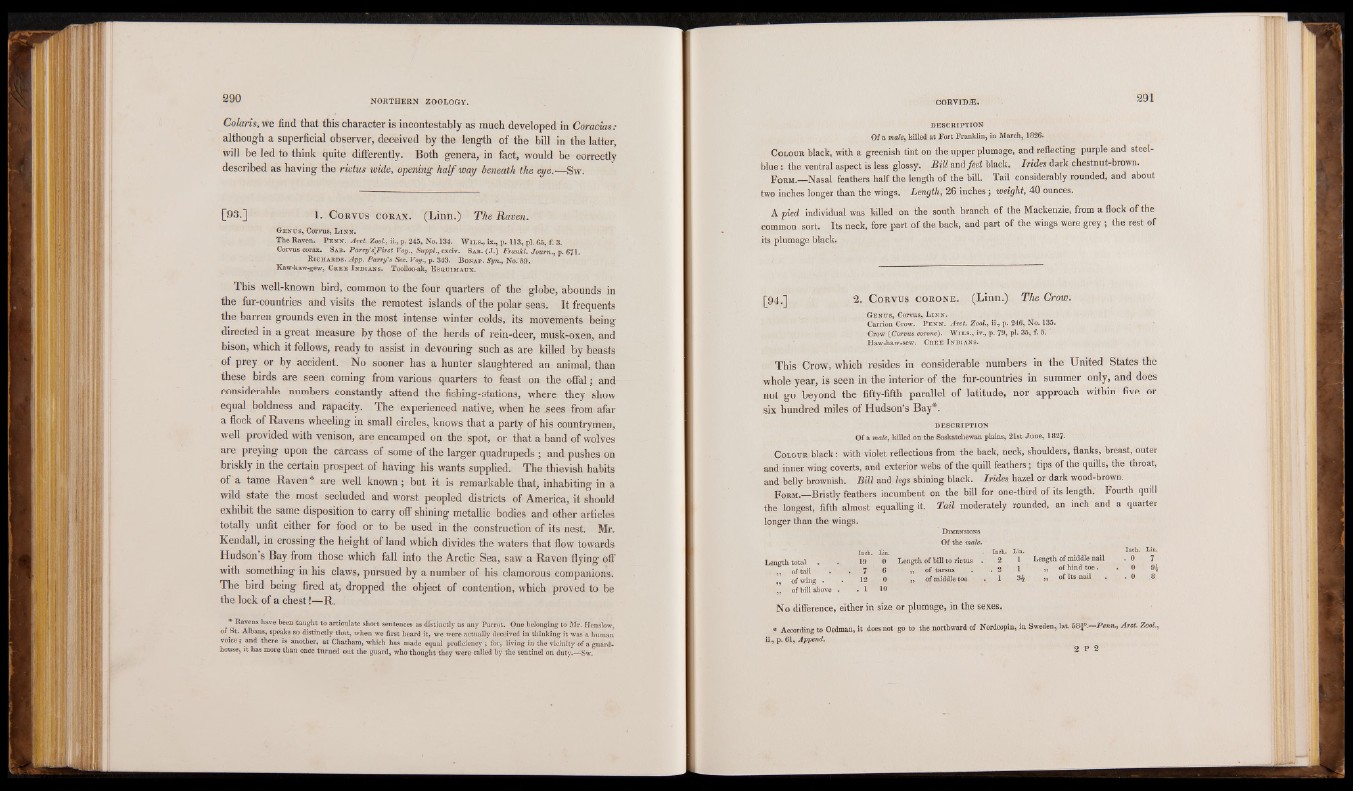
Golaris, we find that this character is incontestably as much developed in Coracias: although a superficial observer, deceived by the length of the bill in the latter,
will be led to think quite differently. Both genera, in fact, would be correctly
described as having the rictus wide, opening half way beneath the eye.—Sw.
[93-3 1. Corvus c o r a x . (Linn.) The Raven.
Ge n u s , Corvus, L in n .
The Raven. P e n n . Arct. Zool., ii., p. 245, No. 134. W il s ., ix., p. 113, pi. 65, f. 3.
Corvus corax. Sab. Parry’s'First Voy., Suppl., cxciv. Sab. (J.) Frankl. Journ., p. 671.
R ic h a r d s. App. Parry's Sec. Voy., p. 343. B onap. Syn., No. 59.
Kaw-kaw-gew, Cr e e I n dia ns. Toolloo-ak, E sq uim a ux .
This well-known bird, common to the four quarters of the globe, abounds in
the fur-countries and visits the remotest islands of the polar seas. It frequents
the barren grounds even in the most intense winter colds, its movements being
directed in a great measure by those of the herds of rein-deer, musk-oxen, and
bison, which it follows, ready to assist in devouring such as are killed by beasts
of prey or by accident. No sooner has a hunter slaughtered an animal, than
these birds are seen coming from various quarters to feast on the offal; and
considerable numbers constantly attend the fishing-stations, where they show
equal boldness and rapacity. The experienced native, when he .sees from afar
a flock of Ravens wheeling in small circles, knows that a party of his countrymen,
well provided with venison, are encamped on the spot, or that a band of wolves
are preying upon the carcass of some of the larger quadrupeds ; and pushes on
briskly in the certain prospect of having his wants supplied. The thievish habits
of a tame Raven * are well known; but it is remarkable that, inhabiting in a
wild state the most secluded and worst peopled districts of America, it should
exhibit the same disposition to carry off shining metallic bodies and other articles
totally unfit either for food or to be used in the construction of its nest. Mr.
Kendall, in crossing the height of land which divides the waters that flow towards
Hudson s Bay from those which fall into the Arctic Sea, saw a Raven flying off
with something in his claws, pursued by a number of his clamorous companions.
The bird being fired at, dropped the object of contention,the lock of a chest!—R. which proved to be
* ®,avens have been taught to articulate short sentences as distinctly as any Parrot. One belonging to Mr. Henslow,
of St. Albans, speaks so distinctly that, when we first heard it, we were actually deceived in thinking it was a human
voice; and there is another, at Chatham, which has made equal proficiency; for, living in the vicinity of a guardhouse,
it has more than once turned out the guard, who thought they were called by the sentinel on duty.—Sw.
DESCRIPTION
Of a male, killed at Fort Franklin, in March, 1826.
Colour black, with a greenish tint on the upper plumage, and reflecting purple and steel-
blue : the ventral aspect is less glossy. Bill and feet black. Irides dark chestnut-brown.
F orm.—-Nasal feathers half the length of the bill. Tail considerably rounded, and about
two inches longer than the wings. Length, 26 inches; weight, 40 ounces.
A pied individual was killed on the south branch of the Mackenzie, from a flock of the
common sort. Its neck, fore part of the back, and part of the wings were grey ; the rest of
its plumage black.
£9 4 .] 2. C o r v u s c o r o n e . (L in n .) The Crow.
Ge n u s , Corvus, L in n . Carrion Crow. P e n n . Arct. Zool., ii., p. 246, No. 135.
Crow (Corpus corone'). W i l s ., iv ., p . 7 9 , p i. 3 5 , f. 5.
Haw-haw-sew. Cr e e I n d ia n s.
This Crow, which resides in considerable numbers in the United States the
whole year, is seen in the interior of the fur-countries in summer only, and does
not go beyond the fifty-fifth parallel of latitude, nor approach within five or
six hundred miles of Hudson’s Bay*.
DESCRIPTION
Of a male, killed on the Saskatchewan plains, 21st June, 1827.
Colour black: with violet reflections from the back, neck, shoulders, flanks, breast, outer
and inner wing coverts, and exterior webs of the quill feathers; tips of the quills, the throat,
and belly brownish. Bill and legs shining black. Irides hazel or dark wood-brown.
Form.—Bristly feathers incumbent on the bill for one-third of its length. Fourth quill
the longest, fifth almost equalling it. Tail moderately rounded, an inch and a quarter
longer than the wings.
Dimensions
Of the male.
Inch. Lin; .- Inch. Lin. ; \ Inci- L" ‘* Length total . . 19 0 Length of bill to rictus . 2 1 Length of middle nail . 0 7
of tail . . 7 6 „ of tarsus . . 2 1 „ of hind toe. . 0 9£
” of wing . . 12 0 ,, of middle toe . 1 3$ n.- of its nail . . 0 8
V „ of bill above . . 1 10
No difference, either in size or plumage, in the sexes.
* According to Oedman, it does not go to the northward of Nordcopin, in Sweden, lat. 58\°.—Penn., Arct. Zool.,
ii., p. 61, Append.
2 P 2